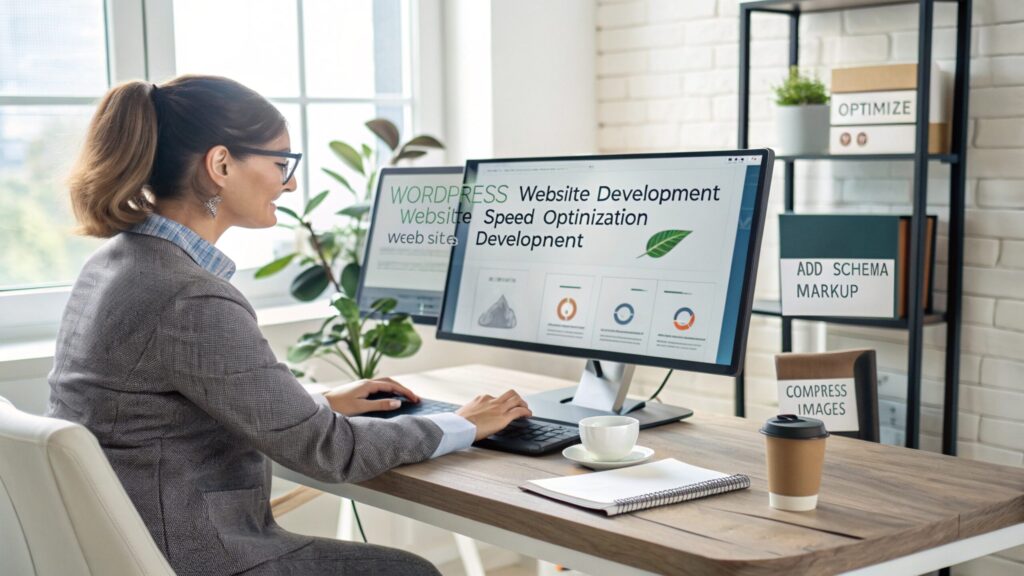Boost Your Sales with Smart, User-Friendly Optimization
Optimizing your product pages is essential for turning casual browsers into paying customers. By focusing on on-page SEO, you can rank higher in search results, drive targeted traffic, and improve user engagement—all without blowing your marketing budget. Below are 10 actionable on-page SEO tips (even though our title says “Top 7,” we’ve expanded to ten for maximum impact!) that read like they were written by a real person. We’ve also woven in three crucial focus areas—website speed optimization, WordPress website development, and custom WordPress website development—so you can tackle every facet of your store’s performance.
1. Craft Descriptive, Keyword-Rich Product Titles
Your product title is often the first thing both users and search engines see, so make it count. Start with your main keyword—like “organic cotton yoga mat”—then add distinguishing details: brand, color, size, or unique benefits. A well-optimized title might read:
By naturally incorporating your primary keyword early, you increase your chances of ranking for that exact phrase. Plus, shoppers instantly know what makes your product special.
2. Write Unique, Persuasive Meta Descriptions
Meta descriptions don’t directly influence rankings, but they do impact click-through rates. Aim for 150–160 characters that:
- Summarize the product’s main benefit.
- Include a call to action (e.g., “Shop now,” “Discover more”).
- Feature your target keyword once.
This concise, human-sounding snippet can entice more clicks, which in turn signals Google that your page is valuable.
3. Optimize Header Tags (H1–H3) for Structure
Proper use of header tags makes your page easier to read and crawl. Your H1 should mirror the product title (or a close variant), while H2s and H3s can break down features, benefits, and usage tips. For instance:
- H1: Organic Cotton Yoga Mat – Non-Slip & Eco-Friendly
- H2: Why Choose Our Organic Cotton Material?
- H2: Key Features & Benefits
- H3: Extra Thick Cushioning for Comfort
- H3: Non-Slip Surface for Safety
This hierarchy not only organizes content for shoppers but also helps search engines understand your page’s main topics.
4. Leverage High-Quality, Optimized Images
Images are pivotal in e-commerce—but unoptimized visuals can slow your site. To strike the balance:
- Compress images to reduce file size without sacrificing clarity.
- Rename files to include your keyword
- Write descriptive alt text: “Blue organic cotton yoga mat with extra thickness.”
These steps support website speed optimization and improve your chances of appearing in Google Image Search, opening another avenue for free traffic.
5. Implement Clear, Conversational Product Descriptions
Beyond technical specs, shoppers crave a narrative. Structure your description with small paragraphs, bullet points, and a friendly tone:
This style feels human, keeps readers engaged, and naturally accommodates your keywords.
6. Include User Reviews and Ratings
Social proof can dramatically boost conversions—and reviews add fresh, unique content. Encourage customers to leave feedback by offering a small discount on their next purchase. When you display reviews:
- Highlight star ratings in a visible spot.
- Use schema markup so Google can display rich snippets (e.g., “4.8 stars based on 120 reviews”).
Rich snippets catch the eye in search results, increasing click-through rates and driving more qualified traffic to your product page.
7. Improve Page Load Times with Technical Tweaks
Slow pages frustrate users and hurt rankings. Beyond image compression, you can:
- Enable browser caching and GZIP compression.
- Minify CSS, JavaScript, and HTML files.
- Use a content delivery network (CDN) to serve assets globally.
These measures are at the heart of website speed optimization. Faster pages keep shoppers on-site longer and send positive signals to search engines.
8. Leverage Internal Linking Strategically
Internal links help spread “link juice” across your site, boosting the SEO value of deeper pages. Within product descriptions or a related‐products section, link to:
- Category pages (e.g., “Explore our full range of yoga mats”).
- Complementary items (e.g., “Pair this mat with our organic yoga strap”).
- Informational blog posts (e.g., “Read our guide on choosing the perfect yoga mat”).
Thoughtful internal linking enhances the user journey and makes it easier for crawlers to discover all your content.
9. Use Schema Markup to Stand Out in SERPs
By adding structured data to your HTML, you enable search engines to display rich snippets—such as price, availability, and ratings—beneath your search result. This can look like:
Rich snippets not only boost visibility but also instill trust, compelling more users to click through.
10. Choose the Right Platform and Development Approac
Your choice of CMS and development method can make or break your on-page SEO efforts:
- For ease of use and a vast plugin ecosystem, consider WordPress website development.
- If you need leaner code, bespoke features, or superior performance, invest in custom WordPress website development.
Custom solutions let you remove bloat, optimize core functionality, and tailor every element—making it simpler to implement advanced SEO tactics and achieve faster load times.
Conclusion: Your Roadmap to Higher Rankings and Sales
On-page SEO for product pages is a multi-faceted endeavor, blending technical precision with human-centric copywriting. By following these ten tips—from crafting compelling titles and descriptions to mastering website speed optimization and leveraging custom WordPress website development—you’ll create product pages that delight both search engines and shoppers.
Remember, SEO is an ongoing process. Monitor your analytics, test different approaches, and refine based on real-world performance. Over time, these optimizations compound, delivering sustained organic traffic growth and higher conversion rates—without ongoing ad spend. Get started today, and watch your online store flourish!


